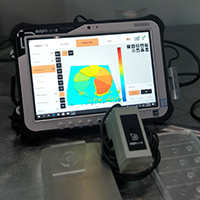Composites and the Application of Non-Destructive Testing
What are composite materials?
As the name suggests composite materials are heterogenous, resulting from combinations of two or more distinct materials. In composite materials the combination of materials is at the macroscopic level, resulting in discrete interfaces separating the constituent elements. When we think of composite materials, polymer-based variants are usually the first to come to mind such as carbon fibre reinforced polymers or glass fibre composites. However, there are also naturally occurring composite materials such as wood. Another commonly used but often overlooked composite material is concrete. Composites need not be complicated, something as simple as papier-mâché, a common craft material, is also classed as a composite material.


The common impetus for developing and using composite materials is to create a material with a combination of properties that is not commonly achievable or practical in homogeneous materials. For example, carbon fibre reinforced polymers (CFRP) are favoured for their incredible strength-to-weight ratio and rigidity up to 2 to 5 times that of aluminium or steel. Properties of CFRP can also be modified by including additives into the binding matrix, rather than adding alloying elements at smelting then further modifying by forging and or heat treatment, as is the case with most engineering metals. Composite materials are Anisotriopic, which means that their properties are not equal in all directions. In engineering composites this usually means means that a composite material’s best mechanical properties will be in line with the direction of the reinforcing material.
Challenges when inspecting composite materials
The boon of being able to combine material properties (eg. the compressive strength of concrete and the tensile strength of steel) can often hinder, but in some cases assist, the non-destructive testing (NDT) of composite materials. NDT involves the introduction of a form of energy to either interact with or pass through a material. In order to detect a flaw in the material, the flaw needs to have properties that contrast with the surrounding material relevant to the energy being used. This property also needs to cause a change in the energy that can be detected and quantified by a sensor (or in some methods a film).
An example to illustrate a positive difference would be the use of ground penetrating radar (GPR) on concrete. With GPR an electromagnetic wave at radio frequency that is often below but sometimes just at the cusp of the microwave frequency range is transmitted into the concrete. To use radio waves for Non-destructive testing, we rely on a flaw or an item we are trying to locate, having significantly different dielectric properties from the surrounding material. In the case of locating and mapping out reinforcement this is excellent, metal has an infinite dielectric constant whereas concrete usually ranges between 5 and 11. This contrast in dielectric will mean that when the radio waves interact with the discrete interface between the concrete and steel reinforcement, the radio waves will be sent back to the antenna for detection. 
As an example of negative difference in a composite, we’ll use concrete as an example again. However, this time we will talk about Ultrasonic testing which uses a mechanical wave to locate flaws. Ultrasonic testing relies on the flaw we are locating to have significantly different Acoustic Impedance properties to our surrounding material. Acoustic Impedance is determined by density and velocity (which is influenced by material density and elasticity). Concrete is a porous mixture of coarse aggregates, fluid cement and often steel reinforcement. It has a myriad of discrete interfaces where there is a difference in acoustic impedance. Therefore, in order to get penetration with ultrasound to detect flaws like delamination or honeycombing, we need to increase our wavelength to a size that won’t interact as much with the other constituents. We do this by reducing our frequency to one that is much lower than what we would use in a homogenous material. This however has a consequence of reducing our sensitivity to smaller flaws.

Hopefully the two examples illustrate some of the challenges in the testing of composite materials. Not only do we have to consider the properties of the various constituents of a composite material, but we also must consider how those properties will interact with the energy we introduce for non-destructive evaluation. Will the flaw we are looking for produce a stronger response than the already existing interfaces between the materials? Will those interfaces reflect, scatter and/or attenuate the energy in a manner that makes it difficult or impossible to return energy changes from flaws, back to our sensor? These are questions we will need to consider whether we are testing natural composites like wood or testing sophisticated engineering composites like those used in aerospace.




